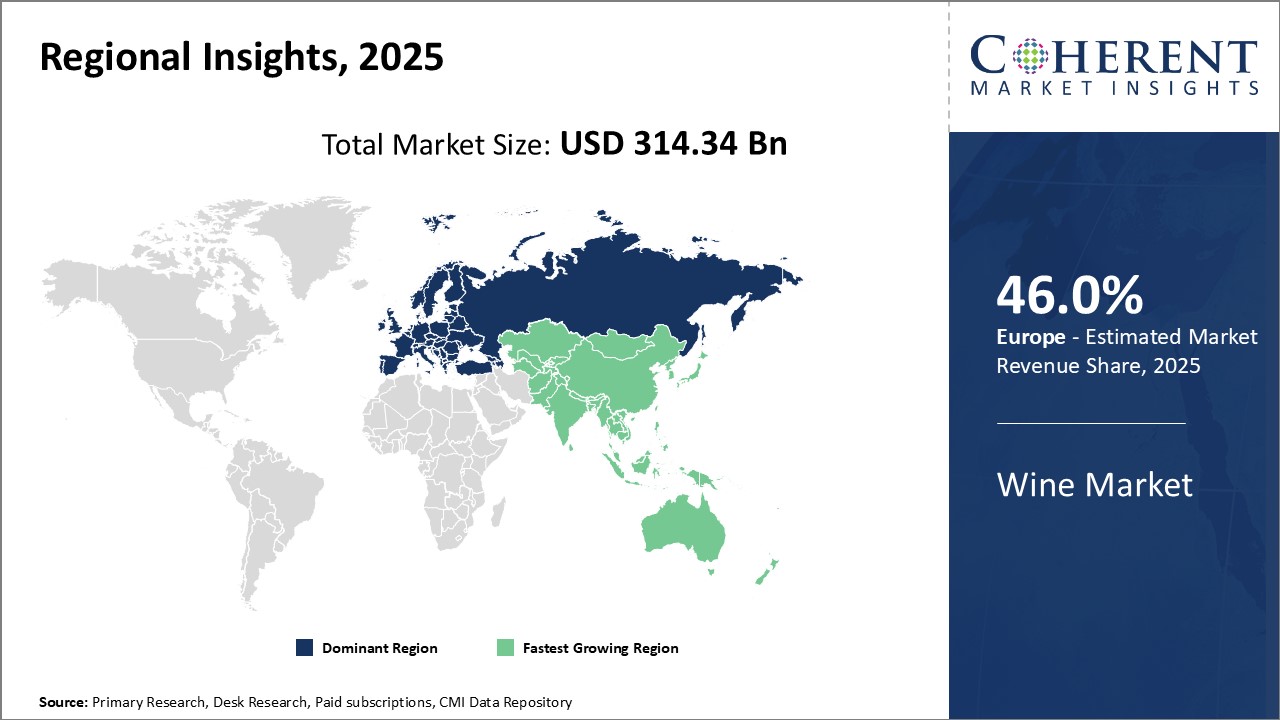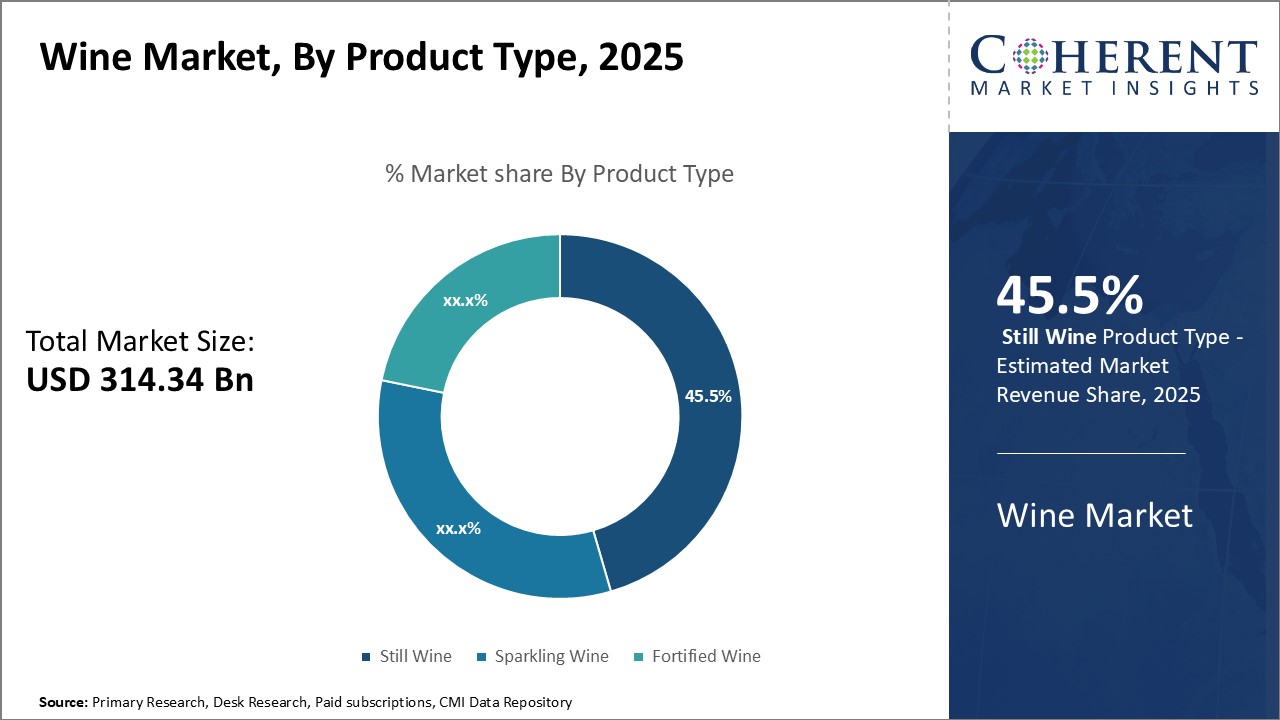Global wine market is expected to reach US$ 422.08 Bn by 2032, from US$ 314.34 Bn in 2025, exhibiting a compound annual growth rate (CAGR) of 4.30% during the forecast period (2025-2032).
Growing women alcohol consumers, expansion of bars and restaurants, exploring different forms of entertainment such as night parties, growing demand from emerging economies, and preference for low calorie alcoholic beverages are expected to drive the global wine market.
Global Wine Market- Regional Insights
Figure 1. Wine Market Share (%), By Region, 2025

To learn more about this report, Request sample copy
Analyst’s Views:
Global wine market is expanding due to rising disposable incomes and growing social acceptance of alcohol consumption in developing nations. Wine consumption in Asia Pacific countries is becoming more mainstream, presenting significant opportunities among the wine market players. However, regulations around wine distribution and sale in certain Asia Pacific countries can hamper the market growth while cultural factors still favour beer and spirits over wine locally. Rising temperatures due to climate change could impact wine grape harvests and vineyards in traditional wine growing zones. Wines with health credentials particularly those made from organic grapes have stronger appeal within health-conscious luxury buyers globally. Wine-focused restaurants and hotel chains are expanding globally, thus, providing an important avenue for portfolio diversification and exposure to new customers. Online e-commerce channels now play a progressively larger role in wine sales and promotions around the world, with positive implications for brand discovery and access to niche products.
Market Drivers:
Increasing social acceptance of alcohol consumption: With more social acceptance and a positive perception of alcohol consumption worldwide, wine has increasingly become a popular beverage of choice for many people. In the past decade, wine consumption has grown steadily, especially among the millennial and Generation Z populations. This demographic shift can drive the growth of the market. Young adults nowadays are more open-minded about enjoying wine as a lifestyle drink in social and casual settings such as restaurants, bars, parks and home parties. These people view moderate wine consumption positively as a means of social bonding, relaxing, and enhancing food experience. This change in attitude has encouraged higher experimentation and trials of different wine types and genres beyond conventional choices. Winemakers and retailers have also successfully marketed novel flavors, packaging, and lower-cost offerings to attract newer audiences.
As generations with more liberal social values toward alcohol come of legal drinking age across world economies, wine consumption is expected to continue ascending globally in the foreseeable future. While moderation and responsible drinking practices will remain priority, increasing social freedom and enhanced lifestyle appeals of wine ensure lucrative prospects for the wine industry worldwide.
Increasing consumption of wine among millennial: The consumption patterns of millennials in their 20s and 30s are having a significant impact on shaping the future growth of the market. As this generation establishes themselves in their careers and social lives, their spending habits and openness to try new flavors and varieties are fueling higher wine consumption worldwide. Their preference for convenience, health consciousness, and exploring new cultures through food and drinks has led to rising popularity of lighter bodied, lower alcohol wines as well as "new world" wine regions across Latin America and Australia. This shift favors countries with younger vineyard plantings, which can adapt quicker to evolving tastes.
Growth of online wine sales and wine-focused social media platforms can also drive the market growth. Millennial are more likely, than older generations, to browse reviews, follow influencers, and experiment with different premium wines from the comfort of their homes.
Market Opportunities:
Innovation in product offerings: Innovation in product offerings could provide significant opportunities for growth of the market. As consumer tastes and preferences evolve rapidly, wineries that are able to continually introduce new and improved varieties, blends, flavors, and styles will be best positioned to attract new customers and retain existing customers. One area that holds promise is development of wines made from novel grape varieties or blends that are optimized for certain climate conditions. Innovation in developing new hybrid grape varieties through cross-breeding that are more resilient to warmer temperatures could allow wine production in new areas. This may open entirely new sourcing and market opportunities over the long run.
Another area ripe for innovation is experimentation with aging wines in non-traditional wood or steel containers to impart unique flavor profiles. Many younger consumers are curious to try wines with bold or unusual characteristics. Wineries are creative enough to develop eye-catching labels and marketing campaigns around experiential brands aimed at millennials and Generation Z could gain an edge. As consumers place greater importance on sustainability, options for low-carbon or carbon-neutral wines produced with renewable energy or other eco-friendly techniques may appeal strongly.
Focus on premium and super premium products:
Focusing on premium and super premium wines could indeed represent a great opportunity for the market growth.
More consumers, especially millennials and Gen Z populations, are developing a stronger appreciation for finer quality wines and are willing to pay higher prices for boutique and artisanal wines produced in limited quantities from select vineyards. This shift away from mass-produced "entry level" wines to more distinctive premium offerings provide a promising avenue of growth for winemakers and exporters. Wine-drinking cultures are also evolving beyond tradition regions as new markets open up in Asia Pacific and Latin America present new lucrative consumer bases.
Wine Market Report Coverage
| Report Coverage | Details | ||
|---|---|---|---|
| Base Year: | 2024 | Market Size in 2025: | USD 314.34 Bn |
| Historical Data for: | 2020 To 2024 | Forecast Period: | 2025 To 2032 |
| Forecast Period 2025 to 2032 CAGR: | 4.3% | 2032 Value Projection: | USD 422.08 Bn |
| Geographies covered: |
|
||
| Segments covered: |
|
||
| Companies covered: |
E. & J. Gallo Winery, Concha y Toro, The Wine Group, Bacardi Limited, Constellation Brands, Pernod Ricard, Treasury Wine Estates, Caviro, Grupo Penaflor. |
||
| Growth Drivers: |
|
||
| Restraints & Challenges: |
|
||
Uncover macros and micros vetted on 75+ parameters: Get instant access to report
Market Trends:
Growing popularity of organic and natural wines: The global wine industry has witnessed rising demand for organic and natural wines. Consumers, especially millennials and generation Z, are increasingly health-conscious and prefer wine that is produced in a sustainable manner without heavy use of pesticides, chemical fertilizers and additives.
This rising consumer preference for natural wines has compelled many conventionally operating wineries to shift to low-intervention winemaking practices. These are focusing more on organic and biodynamic farming in the vineyards and minimal processing during wine production. Many new small wineries have also emerged that specialize exclusively in natural wines made from organically grown grapes. The natural wine segment has seen annual growth rates anywhere between 15-25% globally over the last few years. Major retailers and restaurants are also accommodating this demand by dedicating more shelf space and wine lists to organic and natural wines.
Innovation through variety in grape types and Flavors: The global wine market is witnessing an increased trend of innovation through variety in grape types and Flavors. Wineries around the world are experimenting with newer grape varieties and blending techniques to come up with unique Flavour profiles in their wines. This allows them to cater to the evolving tastes of customers and also explore untapped regional terroirs.
For example, in Australia, winemakers grows Mediterranean grapes like Vermentino, Arneis, and Fiano, which were traditionally grown in warmer climate regions of Italy and Spain. These varieties are doing surprisingly well in different soil and climate conditions in Australia. These are helping craft wines with lively acidity and herbal, floral notes that appeal to new age drinkers. In California, there is a rise in Italian and Portuguese grape varieties like Monterey, Tempranillo, and Touriga Nacional. Winemakers find that blending them in small proportions with local favourites like Cabernet and Chardonnay adds layering of flavor and complexity to the wines.
Market Restraints:
Stringent regulations: Strict regulations across various countries are significantly hampering the growth of the market. Stringent norms around wine production, labeling, marketing, and sale have made the market highly fragmented. Countries have established boundaries to protect their domestic wine industries as well as public health. Regulatory hurdles pertaining to transportation, import duties, and tariffs also vary widely across nations. The recent trade wars and political tensions have further complicated the landscape with changes in import/export policies. For example, according to data from the World Trade Organization, China imposed tariffs ranging between 5-10% on Australian wine in 2020, resulting in Australia's wine exports to China declining by over 80% in 2020. Such swift changes in policy disrupts trade flows and planning.
Increased competition from substitute beverages: Increased competition from substitute beverages can hamper the market growth. Craft beers have emerged as a very popular option among millennials and Gen Z drinkers. Large craft brewers have employed innovative marketing strategies to portray their products as fresher, healthier, and more socially conscious alternatives to wine. Furthermore, the consumption of non-alcoholic alternatives like flavored sparkling waters and fruit juices has increased substantially among health-conscious individuals. This market grew at a rate of over 7% from 2020 to 2022, according to Statista, as people pursued refreshment options with no alcohol or sugar content. While these substitutes do not fully replicate the experience of wine, their popularity indicates an evolving dining and drinking landscape where consumers have more choices than ever. As preferences continue shifting, the wine industry will need to devise new strategies to adapt and remain appealing amid stiff competition.
Counterbalance: To overcome this restraint, the key market players need to follow strict rules and regulations, which might increase the global wine market's growth.
Recent Developments:
New Product launches:
Mergers and Acquisition:
Figure 2. Wine Market Share (%), By Product Type, 2025

To learn more about this report, Request sample copy
Top Companies in this Market
Definition: Wine is an alcoholic drink made from fermented fruit. Yeast consumes the sugar in the fruits and converts it to ethanol and carbon dioxide, releasing heat in the process. Though wine can be made from a variety of fruit crop,s such as plum, cherry, pomegranate, blueberry, currant, and elderberry, it is most often made from grapes, and the term "wine" generally refers to grape wine when used without a qualifier.
Share
Share
Missing comfort of reading report in your local language? Find your preferred language :
Transform your Strategy with Exclusive Trending Reports :
Frequently Asked Questions
Select a License Type
Credibility and Certifications

860519526

9001:2015
27001:2022


Joining thousands of companies around the world committed to making the Excellent Business Solutions.
View All Our Clients
US Reciprocal Tax Impact Analysis On Wine Market
Stay updated on tariff changes with expert insights and timely information